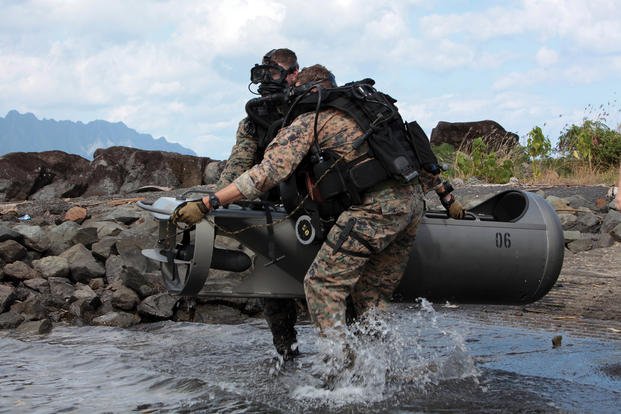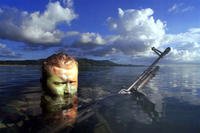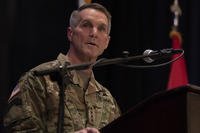CAMP GONSALVES, Okinawa, Japan -- "You can't prep for [the Jungle Warfare Training Center] -- it's not possible, not for the jungle and not for the weather," said Sgt. Matthew J. Foglesong, a team leader and reconnaissance man with Company B, 3rd Reconnaissance Battalion. "You just have to take everything you have learned in the past and make it work for you."
Marines with Company B, 3rd Recon. Bn., 3rd Marine Division, III Marine Expeditionary Force, put their experience to use in overcoming rugged terrain and inclement weather to complete a four-day reconnaissance patrol at the JWTC on Camp Gonsalves, Feb. 19--22, during the final event of a two-week field exercise.
In the training scenario, the Marines' mission was to determine the suitability of a site for the construction and operation of an expeditionary base camp from which to provide humanitarian relief after a major typhoon, as well as determine how passable roads and rivers leading into the affected area were.
"The point of the mission was to provide support, not for a combat mission but for a humanitarian mission in support of a Marine expeditionary unit," said Lance Cpl. Trevor M. Pace, an assistant team leader and reconnaissance man with Company B, 3rd Recon. Bn. "The MEU commander sent us to do reconnaissance to see if he could send resupply into the area of a natural disaster and make sure that it was safe for them to bring in food and supplies. There were hostiles in this scenario, so we used our particular skill set to complete the reconnaissance completely undetected."
The hostiles in the scenario, played by other Marines with 3rd Recon. Bn., represented insurgents operating in areas of reduced government control in an affected nation, complicating the humanitarian assistance and disaster relief operation. The hypothetical nation in the scenario requested the MEU take the lead in areas of reduced government control because of its expeditionary capabilities.
"We can get in and out without making a big footprint," Pace said. "We are not making a huge scene; we are doing it quietly. We went in and provided our reconnaissance. We got the photos and got close to the objectives without being detected."
The Marines adopted the role of a MEU's amphibious reconnaissance platoon for the purposes of the scenario, a role they are scheduled to fill during their deployment with the 31st MEU, III MEF, later this year.
"We can certainly provide information and help the MEU maintain better situational awareness on the ground," said Capt. Brian J. Lusczynski, a platoon commander with Company B. "The techniques we use and the things we look for in the reconnaissance aspects of our mission allow us to be employed in a broad way that would easily allow us to assist HADR missions."
During the exercise, the battalion integrated various simulated elements of the MEU to increase the realism, according to Capt. George F. Mittnacht, the company commander for Company B.
"Training to support the MEU includes working with whatever agencies or parts of the MEU will provide the commander the information he needs, including radio battalions, combat camera assets, human intelligence teams or diplomats," Mittnacht said.
The Okinawa climate cooperated with the Marines training, replicating the after-effects of a typhoon with heavy rainfall leading to and continuing early into the second day of the patrol.
The rain left the Marines battling to carry packs weighing as much as 90 pounds up steep hills made treacherously slick by mud and loose debris, and fighting against plunging temperatures to stay warm at night -- a fight made more difficult by wet clothing and lack of shelter.
"If you can do it here, any other place in the Asia-Pacific region is not going to be an issue," Foglesong said. "[The training] doesn't matter until you are cold, hungry, tired and on your second week in the jungle and everything hurts. This is about learning how to operate at a high level while you are uncomfortable."
Despite the elements and fatigue, the Marines pushed through rough terrain to complete their mission.
"This mission went really well," Pace said. "We started giving the [command center] reports, including a lot of good pictures and information for the MEU commander about this area. We got to go out and be the eyes of the MEU commander and help him make better decisions."
The Marines left the area via special purpose insertion and extraction system upon the completion of their mission, a method designed for the rapid extraction of service members from areas with terrain unsuitable for the landing of aircraft. The reconnaissance men attached themselves by harness to a special purpose insertion and extraction rope suspended from a hovering MV-22B Osprey, which flew them to a nearby landing zone.
The Company B Marines will continue field training in the coming weeks in preparation of their scheduled MEU deployment to build their reconnaissance skills.
"Training is the biggest part of it,'' Pace said. "That is why we train for all of these different scenarios, so that we will be ready for whatever comes.''
Want to Know More About the Military?
Be sure to get the latest news about the U.S. military, as well as critical info about how to join and all the benefits of service. Subscribe to Military.com and receive customized updates delivered straight to your inbox.










